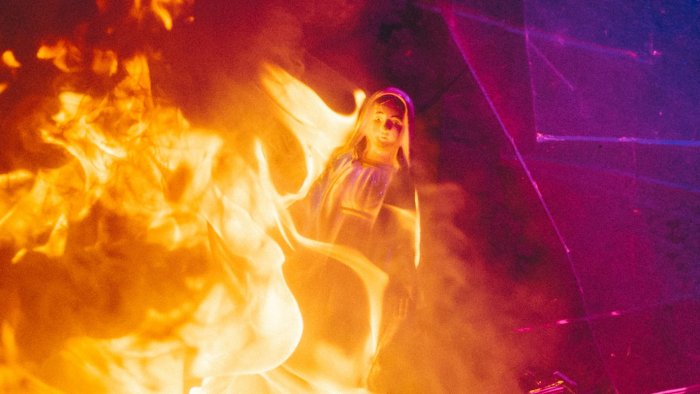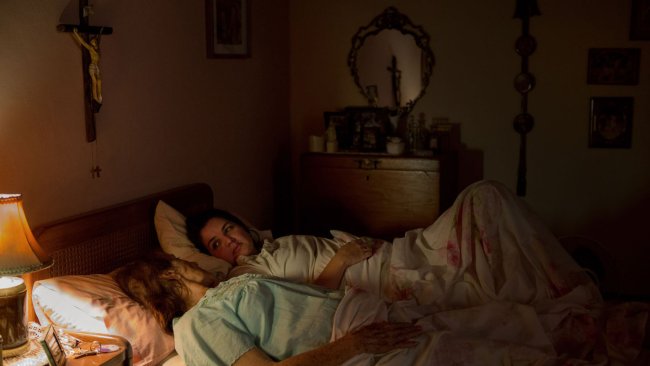Nossa senhora da loja do Chinês
[…] Claver sharply criticises a political and social life – intelligentsia included – that is reduced to elementary relations of power, but his gaze is also able to throw a pathetic connotation on to it.
[…] Ellipses and allusions are stressed by the use of a very poetic text layer (voice over) that counterbalances well the ambitious and panoramic intentions of the film through acute intuitions and in-depth descriptions.
[…] «Nossa senhora da loja do Chinês» is definitely a film to experience together, independently or alongside its understanding.
Text: Giuseppe Di Salvatore

The Prologue comes after the second chapter in a film where the general architecture structures a highly elusive multi-linear storytelling. It comes to help in the understanding of a filmic mosaic that paints the portrait of several social strata in urban Angola (Luanda), from the highest-ranked politicians to the street beggar. Nevertheless Ery Claver’s panoramic intentions are not only social but also historical, insofar as he keeps track of the symbols and relicts of Angolan past, from the Catholic colonialism to the revolutionary discourses.
The physical and temporal landscapes express a general fatigue as many of the protagonists seem to cope with a heavy burden, be it an important damage to the house, the loss of a beloved person (or animal), or the immobility of the political establishment. Almost all of them actually share a loss: a daughter, a dog, a career. This is the intergenerational thread of a film that puts forward the generational difference between an adult and ruling society that by rote repeat and defend an empty discourse in order to hide egoism and corruption, and a younger generation that is embodied by … a killed young woman and a penniless boy.
Claver sharply criticises a political and social life – intelligentsia included – that is reduced to elementary relations of power, but his gaze is also able to throw a pathetic connotation on to it, thanks to the perspective that makes the specificity of Nossa senhora da loja do Chinês: its focus on religion. The Catholic past, the superstitious rituals, and the new rampant presence of Evangelism are all surpassed by the fortune of a neon-lighted Holy Lady that is sold as a sort of lucky mascot or fetish idol by Chinese merchants. And it’s exactly this plastic Holy Lady that seems to be destined to compensate the losses that mark the protagonists of the film. The banal reality of trade and consumerism superimposes on ideologies that have become empty, and introduces a new emptiness.
All of this would make of Claver’s film a pamphlet-like fresco of Luanda if he would have not expressed it through a very original photography and, more generally, a specific aesthetic signature. In conformity with the objectives of the production collective Geração 80 he is responsible for a hallucinated and sometime psychedelic camera (such as in Fradique’s Air Conditioner), which creates an intriguing balance with the general naturalist approach. The sometimes heavily symbolic, declarative style that one can easily find in African social realism is also interestingly mixed with a fragmentary architecture that favours the ellipse and the allusion. Ellipses and allusions are stressed by the use of a very poetic text layer (voice over) that counterbalances well the ambitious and panoramic intentions of the film through acute intuitions and in-depth descriptions. Nossa senhora da loja do Chinês is definitely a film to experience together, independently or alongside its understanding.
And – a true coup de génie by Claver! – the voice over speaks Mandarin. The most alien and the most intimate aspects of the film conflate. The Chinese merchant and the poet-storyteller coincide, so taking advantage of the privilege of a distant perspective – China, poetry – from which the panoramic overview of society joins to the poetic exploration of its most unconfessed feelings.
This article contains a third-party video. If you would like to watch the video, please adjust your settings.
Info
Nossa senhora da loja do Chinês (Our Lady of the Chinese Shop) | Film | Ery Claver | ANG 2022 | 98’ | Locarno Film Festival 2022
First published: August 20, 2022



